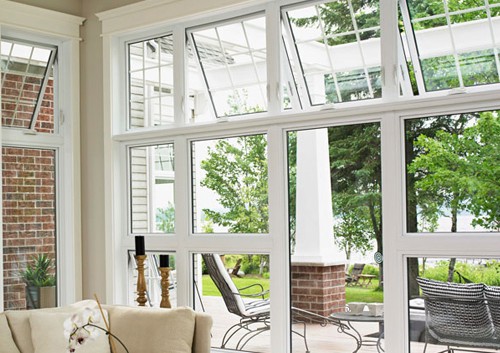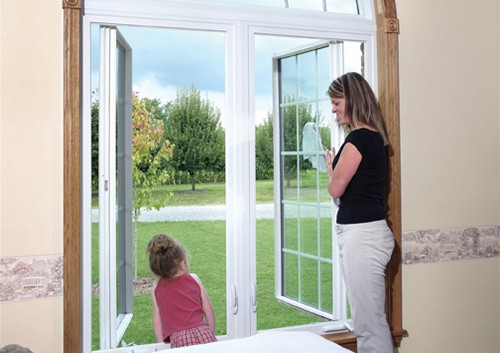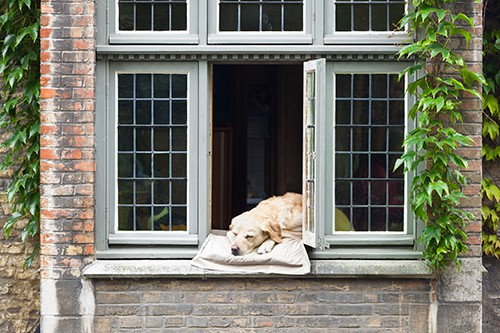Windows open a house to the world. They bring in a view of the outdoors, sunlight, ventilation, and warmth. The same features that positively impact the view can also have a negative impact on a homeowner’s pocketbook. Increasing the energy efficiency of a home’s windows will reduce the annual cost of utility bills.
One of the best investments a homeowner can make is in energy-efficient windows for their house. The windows will eventually pay for themselves through a reduction of the home’s energy costs.
Energy efficient windows can also save money on lighting. With less efficient windows, window coverings stay closed more often to keep out the heat and cold. This causes the inhabitants of the home to have to keep more lights on during the daylight hours. With energy-efficient windows, you can use the natural light of the outdoors, so you spend less money on powering and replacing lights.
Heat Conduction
Windows conduct heat through the window glass and frame and through leakage of air around them. How much heat a window gains or loses through the glass is one of the rated factors of energy performance.
 U-factor. This is the rate at which the window conducts heat flow. With windows, this number is referring to only the glass or glazing. The ratings issued by the National Fenestration Rating Council (NFRC) are representative of the performance of the whole window. This includes the spacer material and the frame. The more energy efficient the window is, the lower the U-factor rating will be.
U-factor. This is the rate at which the window conducts heat flow. With windows, this number is referring to only the glass or glazing. The ratings issued by the National Fenestration Rating Council (NFRC) are representative of the performance of the whole window. This includes the spacer material and the frame. The more energy efficient the window is, the lower the U-factor rating will be.- Solar heat gain coefficient (SHGC). This refers to the solar radiation allowed to come through the window. The window may transmit or absorb the radiation directly and then release it as interior heat. High SHGC ratings indicate that a window will effectively collect heat during cold months. Low SHGC rated windows are better for keeping cooling costs low during the hot summer months.
- Air leakage. The air leakage rate measures the amount of air movement that occurs around the window itself. The lower the leakage rating, the less outside air will escape into the house.
Transmittance of Sunlight
Glazing on the window affects sunlight transmission through the window and into the home. The characteristics measured to rate the energy performance of sunlight transmittance include:
- Visible transmittance (VT). VT ratings range from 0 to 1. A higher VT rating indicates that the window will transmit more light.
- Light-to-solar gain (LSG). The number for LSG is an expression representing the ratio between solar heat gain coefficient (SHGC) and VT. It provides a gauge to measure the daylight transmission efficiency of different glazing and glass compared to the ability to block heat. If the number is higher, the window will transmit more light without adding a great amount of additional heat.
Once you decide to upgrade the home to new energy efficient windows, you must consider several factors:
- Design
- Selection
- Installation
Design Considerations
 Deciding what type of window to place in each area of the house is the first step. You will need to consider the house itself and where it’s located. Energy efficient windows are labeled according to the climate. These labeling ratings, however, don’t consider the design factors of your home. The orientation of the windows and shade versus sun exposure are important things to take note of.
Deciding what type of window to place in each area of the house is the first step. You will need to consider the house itself and where it’s located. Energy efficient windows are labeled according to the climate. These labeling ratings, however, don’t consider the design factors of your home. The orientation of the windows and shade versus sun exposure are important things to take note of.
South Facing Windows
In climates that have a high percentage of chilly weather months throughout the year, areas of higher glazing should be south facing. This allows them to absorb solar heat during cold days when the sun’s position in the sky is lower. During the summer, the sun’s position is higher in the sky. You can use overhangs and awnings, so heat gain isn’t excessive.
Windows that face the south in cooler climates will be most effective if they have a:
- SHGC that exceeds 0.6. This maximizes the heat gain through solar absorption during winter months.
- U-factor that’s 0.35 or lower to decrease the conductive heat transfer.
- VT that’s rated high, so windows will let a high rate of sunlight through to light the home.
For hotter climates, experts recommend a lower SHGC to reduce cooling costs.
North Facing Windows
Windows facing the north are mostly used for lighting in cooler climates, as they don’t collect very much solar heat. Window glazing that’s low-emissivity (low-E) helps control the gain and loss of solar heat in cold weather. In hotter climates, a low SHGC rating will help keep cooling costs lower.
East and West Facing Windows
These windows provide daylight but it’s challenging to control light and heat through them when the sun’s sky position is lower. It’s best if the windows facing east and west have a lower SHGC and shading.
Window Selection
 There are several options to review before selecting which window type to use in a home.
There are several options to review before selecting which window type to use in a home.
The first consideration is the energy performance rating of a window and how it relates to the climate you live in and the home’s design. This step will narrow the selection of window choices that are appropriate.
If the climate in which the house is located experiences both hot and cold seasons, windows with a low SHGC and U-factor will provide the best energy savings. There may be a choice between the center of glass (COG) and whole-unit numbers. The whole-unit SHGCs and U-factors are a more accurate representation of the entire product’s energy performance.
All the components that make up the window’s construction affect its energy efficiency.
- Window frame. The frame of the window is a heat conductor. This factor contributes to the window’s U-factor and the product’s overall energy efficiency.
- Glazing. Glass technologies and glazing are highly developed. There are many kinds of glass and glazing available for windows.
- Operation. How a window operates is an important consideration. The mechanics of some types of windows allow more air to leak through than others. The lower the air leakage, the greater the energy efficiency.
Common Window Operation Options
Energy efficient windows come in many distinctive styles. The type of window that’s chosen should be based on energy efficiency, the design of the house, the features that are important to the homeowner, and the people who will be operating the windows.
 Awning. These windows have a hinge at the top, which allows them to open outward. When closed, the sash at the bottom presses against the window’s frame. This type of window allows less air leakage than the type of window that slides.
Awning. These windows have a hinge at the top, which allows them to open outward. When closed, the sash at the bottom presses against the window’s frame. This type of window allows less air leakage than the type of window that slides.- Casement. Because these have hinges at the side, the sash presses against the frame when it’s closed. Like an awning style of window, these usually leak less air because they have hinges at the sides.
- Fixed. This style doesn’t open at all. If they are properly installed, they are completely airtight. This is excellent for energy efficiency but not a desirable choice in areas where you need ventilation.
- Hopper. Opening inward on hinges located at the bottom of the window, these windows also have a sash that presses against the frame. The air leakage rate is usually comparable to the casement and awning windows.
- Double and Single Hung. These windows slide vertically. Double-hung sliding allows you to open the window from the bottom and the top. You can open single-hung windows only from the bottom. The leakage rate is generally higher on these windows than the hinged styles.
- Double and Single Sliding. Like the double and single hung windows, these windows slide. The difference is that these windows slide horizontally. With the double sliding window, both sides of the window open. You can open single sliding windows only from one side. As a sliding window, it is generally higher on the leakage rate scale.
Window Installation
Proper installation is essential to maximize the energy efficiency of the windows selected. The installation process and procedure are dependent on the type of window, how the house was built, and any weather restrictive barriers used.
Each window has specific manufacturer recommendations for proper installation. Following these instructions is important to ensure the windows are properly air sealed for maximum energy efficiency. This will involve caulking the frame and weather stripping certain components of the window.
Having windows professionally installed can save a lot of headaches and costly repair work down the road. Call now for a free estimate and experience Mr. Roof’s award-winning customer service and transparent pricing.
Find A Local Mr. Roof Near You
Mr. Roof offers our services throughout the Midwest. When you need windows, siding, gutters, masonry, insulation or roofing in your local area, contact the professionals at Mr. Roof. You can find a local Mr. Roof here: https://www.mrroof.com/locations/









